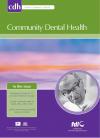Community Dental Health

- Cover Date:
- June 2008
- Print ISSN:
- 0265 539X
- Vol:
- 25
- Issue:
- 2
Prediction of periodontal pathology around third molars using linear mixed effects modeling
Objective To compare the random intercept multilevel model with other linear mixed effects models in an assessment of the effect of quadrant-, jaw-, and person level covariates on probing depth of asymptomatic third molars. Basic Research Design Five different covariance models were considered: 1) the random intercept multilevel 2) multi-level with unequal jaw variance 3) multi-level with unequal tooth variance 4) multi-level with unequal jaw and side variance and 5) the general linear model for correlated data with unstructured covariance matrix. Participants 235 subjects with all four third molars erupted were included. Fifty-one percent were female and 75% Caucasian. The average age was 29.1 years (sd = 7.0). Results The extended multi-level with unequal residual variance was the best fit to the data. Likelihood ratio tests in a stepdown selection approach resulted in a final model for mean probing depth that included one statistically significant three-way interaction (age x gingival inflammation x gender), two statistically significant two-way interactions (jaw x gingival inflammation and jaw x gender) and one significant main effect (ethnicity). Conclusions Linear mixed effects modeling is a powerful tool for the analysis of correlated dental data. However, no one covariance structure is appropriate for all purposes.
Key words: Linear mixed effects model, periodontal pathology, third molar
- Article Price
- £15.00
- Institution Article Price
- £
- Page Start
- 89
- Page End
- 97
- Authors
- C. Phillips, J.S. Preisser, R. White Jr., G.H. Blakey, R.H. Haug
Articles from this issue
- Title
- Pg. Start
- Pg. End
- Editotial - Do we let children’s teeth decay just because some people object to topping up the natural fluoride that’s already in our water?
- 66
- 69
- Dental caries rates in primary teeth in 2002, and caries surveillance trends 1981-2002, in a South African city.
- 79
- 83
- Individual and maternal determinants of self–reported dental health among Turkish school children aged 10-12 years.
- 84
- 88
- Comparison of ranking dental status using the Significant Caries Index and the Significant Filled and Sound-Teeth Index
- 103
- 106
- Measuring oral health behaviour in Flemish health care workers: an application of the Theory of Planned Behaviour
- 107
- 114
